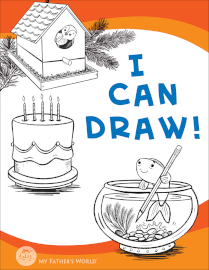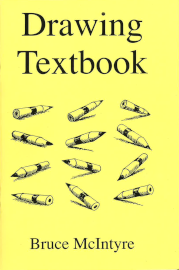Bruce McIntyre’s resources have been used by people of all ages to learn basic drawing skills for more than 50 years. McIntyre worked as a Disney artist on classics, such as Pinocchio, Dumbo, and Fantasia, and became convinced that anyone could learn to draw by learning the basic principles. After leaving Disney, he developed methods for teaching those skills to children and adults. He has published numerous books and television series, including some that were used for college students. (I took one of his televised courses through our local junior college many years ago and loved it!)
His Drawing Textbook remains one of the most succinct and well-structured resources for learning the seven basic skills. This half-page-size book has only 62 pages, but within those pages are 222 drawing assignments that begin with a birthday cake with foreshortened circles and conclude with a drawing of a ball of wool on the ground—much trickier than it sounds. Drawing assignments are grouped into 37 lessons, with six assignments per lesson. Students need only a pencil and paper, but the paper should be in a book as I explain later.
Lessons progress in difficulty rather quickly. By Lesson Five, students are drawing (in three dimensions) a telescope pointed in a particular direction, a mountain range, a pail of water, a scroll, a simple house with windows against a mountain range (with the house angled so two sides are visible), and rocks in water. By Lesson Thirty, students have advanced enough to draw a camel standing at an angle, two poles slanted against each other in water, the word TIME in 3D, a cylinder with a section removed, a wishing well, and a lifelike human ear. Among other assignments are flying saucers, a helicopter, buildings drawn from different vantage points, and much more. There is a playful aspect to many of the assignments that makes them fun for students.
Note that Drawing Textbook does not teach drawing the human figure, but McIntyre has a separate book on how to draw people titled Best Book on Drawing People. McIntyre's books are published by Draw with Bruce and are available through their website.
A paragraph of instruction is provided for each assignment. Students build incrementally upon basic skills, so they need to complete every assignment in order. Instructions at the beginning provide important background for the parent or teacher, but it should take very little time to get started.
I Can Draw!
 Drawings should be done small, and they can be completed in less time than you might think. To help students keep their drawings manageable, My Father’s World has published I Can Draw!, a 46-page book in which students can draw their assignments. Most pages are divided into six boxes. The first three pages for each lesson in I Can Draw! label only the two boxes at the top with the names of two assignments. Under each labeled box are two blank boxes, so students can practice each assignment up to three times if they wish. The fourth page for each lesson labels all six boxes for students to do a final drawing of each assignment. Younger students might need to use all the boxes for some assignments, while older or more skilled students might not. The course does not require students to do each assignment more than once, so it is up to parents to decide how much practice is worthwhile. I think I Can Draw! Will be useful for younger students, but I would consider having students in junior high and above use a sketchbook without boxes. Either way, student’s drawings should be in a book so their progress from start to finish is readily visible.
Drawings should be done small, and they can be completed in less time than you might think. To help students keep their drawings manageable, My Father’s World has published I Can Draw!, a 46-page book in which students can draw their assignments. Most pages are divided into six boxes. The first three pages for each lesson in I Can Draw! label only the two boxes at the top with the names of two assignments. Under each labeled box are two blank boxes, so students can practice each assignment up to three times if they wish. The fourth page for each lesson labels all six boxes for students to do a final drawing of each assignment. Younger students might need to use all the boxes for some assignments, while older or more skilled students might not. The course does not require students to do each assignment more than once, so it is up to parents to decide how much practice is worthwhile. I think I Can Draw! Will be useful for younger students, but I would consider having students in junior high and above use a sketchbook without boxes. Either way, student’s drawings should be in a book so their progress from start to finish is readily visible.
I chose to review these two books together since Drawing Textbook seems to be available only throughdrawwithbruce.com and My Father’s World, and if you want both books, purchasing them together from My Father’s World might be the most practical option. The two books are also included in the package for My Father's World's third-grade course, World Changers.
Summary
I love McIntyre’s straightforward approach to teaching drawing because it makes drawing skills accessible to all students.








